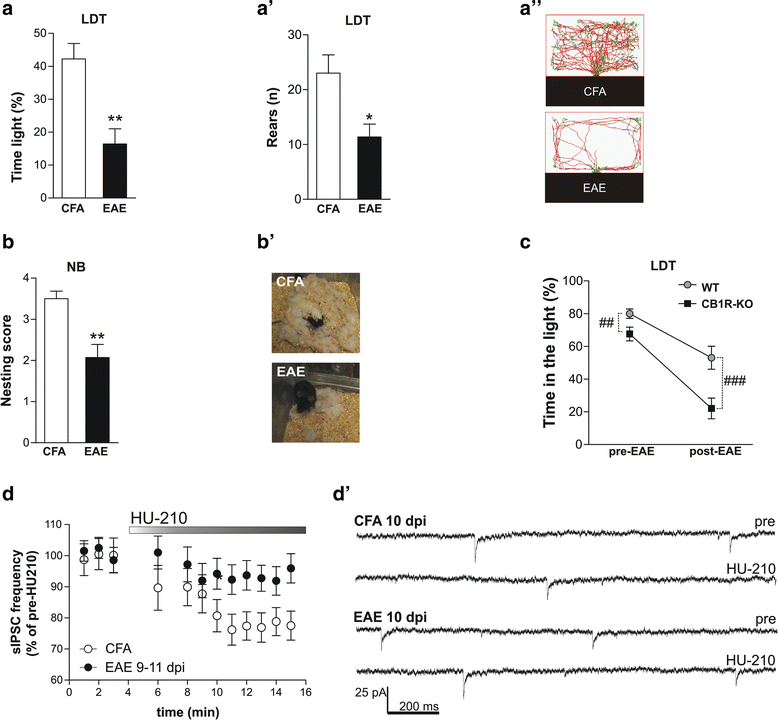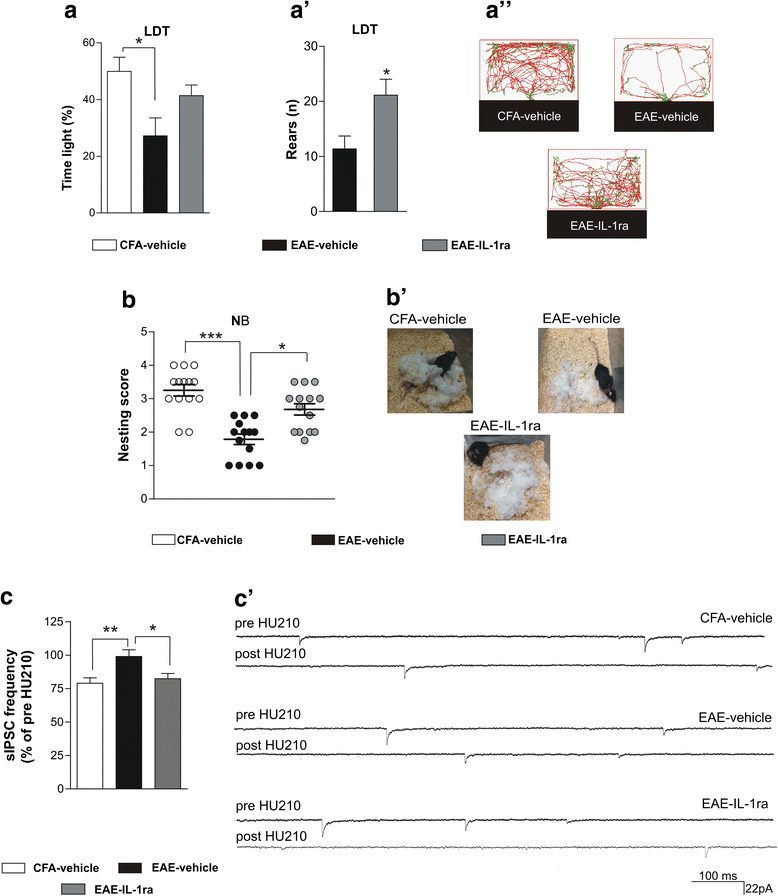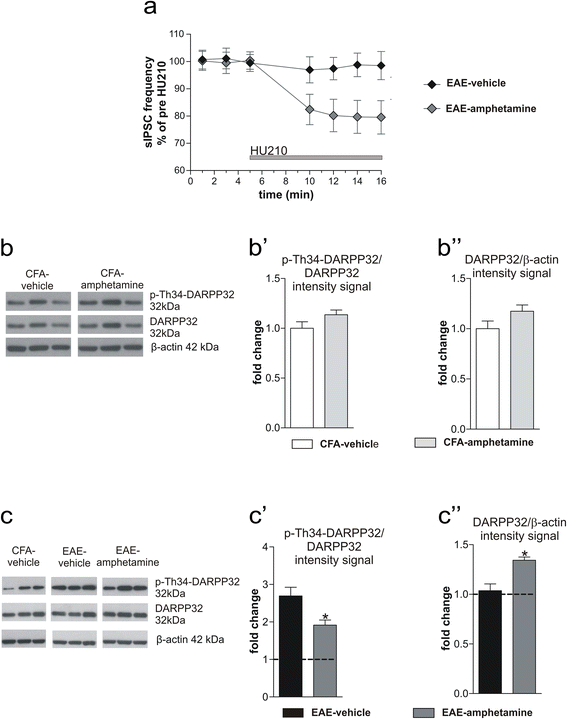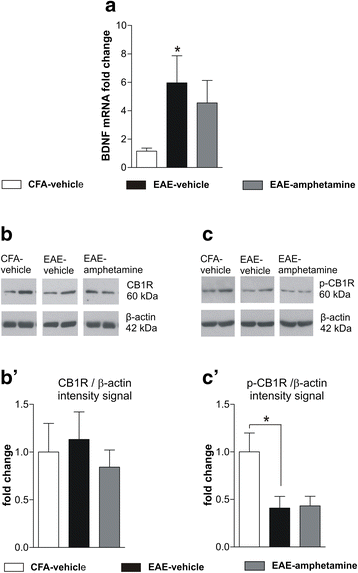Interaction between interleukin-1β and type-1 cannabinoid receptor is involved in anxiety-like behavior in experimental autoimmune encephalomyelitis
- PMID: 27589957
- PMCID: PMC5009553
- DOI: 10.1186/s12974-016-0682-8
Interaction between interleukin-1β and type-1 cannabinoid receptor is involved in anxiety-like behavior in experimental autoimmune encephalomyelitis
Abstract
Background: Mood disorders, including anxiety and depression, are frequently diagnosed in multiple sclerosis (MS) patients, even independently of the disabling symptoms associated with the disease. Anatomical, biochemical, and pharmacological evidence indicates that type-1 cannabinoid receptor (CB1R) is implicated in the control of emotional behavior and is modulated during inflammatory neurodegenerative diseases such as MS and experimental autoimmune encephalomyelitis (EAE).
Methods: We investigated whether CB1R could exert a role in anxiety-like behavior in mice with EAE. We performed behavioral, pharmacological, and electrophysiological experiments to explore the link between central inflammation, mood, and CB1R function in EAE.
Results: We observed that EAE-induced anxiety was associated with the downregulation of CB1R-mediated control of striatal GABA synaptic transmission and was exacerbated in mice lacking CB1R (CB1R-KO mice). Central blockade of interleukin-1β (IL-1β) reversed the anxiety-like phenotype of EAE mice, an effect associated with the concomitant rescue of dopamine (DA)-regulated spontaneous behavior, and DA-CB1R neurotransmission, leading to the rescue of striatal CB1R sensitivity.
Conclusions: Overall, results of the present investigation indicate that synaptic dysfunction linked to CB1R is involved in EAE-related anxiety and motivation-based behavior and contribute to clarify the complex neurobiological mechanisms underlying mood disorders associated to MS.
Keywords: Anxiety; Experimental autoimmune encephalomyelitis; Interleukin-1β; Striatum; Type-1 cannabinoid receptor.
Figures




Similar articles
-
Interferon-γ causes mood abnormalities by altering cannabinoid CB1 receptor function in the mouse striatum.Neurobiol Dis. 2017 Dec;108:45-53. doi: 10.1016/j.nbd.2017.07.019. Epub 2017 Jul 27. Neurobiol Dis. 2017. PMID: 28757328
-
Pre- and postsynaptic type-1 cannabinoid receptors control the alterations of glutamate transmission in experimental autoimmune encephalomyelitis.Neuropharmacology. 2014 Apr;79:567-72. doi: 10.1016/j.neuropharm.2014.01.007. Epub 2014 Jan 15. Neuropharmacology. 2014. PMID: 24440366
-
Immunoregulation of experimental autoimmune encephalomyelitis by the selective CB1 receptor antagonist.J Neurosci Res. 2012 Jan;90(1):84-95. doi: 10.1002/jnr.22721. Epub 2011 Sep 15. J Neurosci Res. 2012. PMID: 21922514
-
IL-1β dependent cerebellar synaptopathy in a mouse mode of multiple sclerosis.Cerebellum. 2015 Feb;14(1):19-22. doi: 10.1007/s12311-014-0613-0. Cerebellum. 2015. PMID: 25326653 Review.
-
Novel insights into the mechanisms underlying depression-associated experimental autoimmune encephalomyelitis.Prog Neuropsychopharmacol Biol Psychiatry. 2019 Jul 13;93:1-10. doi: 10.1016/j.pnpbp.2019.03.001. Epub 2019 Mar 5. Prog Neuropsychopharmacol Biol Psychiatry. 2019. PMID: 30849414 Review.
Cited by
-
Microglia and CNS Interleukin-1: Beyond Immunological Concepts.Front Neurol. 2018 Jan 23;9:8. doi: 10.3389/fneur.2018.00008. eCollection 2018. Front Neurol. 2018. PMID: 29410649 Free PMC article. Review.
-
Inflammation-Associated Synaptic Alterations as Shared Threads in Depression and Multiple Sclerosis.Front Cell Neurosci. 2020 Jun 23;14:169. doi: 10.3389/fncel.2020.00169. eCollection 2020. Front Cell Neurosci. 2020. PMID: 32655374 Free PMC article. Review.
-
Effects of gut-derived endotoxin on anxiety-like and repetitive behaviors in male and female mice.Biol Sex Differ. 2018 Jan 19;9(1):7. doi: 10.1186/s13293-018-0166-x. Biol Sex Differ. 2018. PMID: 29351816 Free PMC article.
-
Interplay Between Age and Neuroinflammation in Multiple Sclerosis: Effects on Motor and Cognitive Functions.Front Aging Neurosci. 2018 Aug 8;10:238. doi: 10.3389/fnagi.2018.00238. eCollection 2018. Front Aging Neurosci. 2018. PMID: 30135651 Free PMC article. Review.
-
Exploring the Psychiatric Manifestations of Primary Sjögren's Syndrome: A Narrative Review.Int J Rheumatol. 2024 May 14;2024:5520927. doi: 10.1155/2024/5520927. eCollection 2024. Int J Rheumatol. 2024. PMID: 38774059 Free PMC article. Review.
References
-
- Kahl KG, Kruse N, Faller H, Weiss H, Rieckmann P. Expression of tumor necrosis factor-alpha and interferon-gamma mRNA in blood cells correlates with depression scores during an acute attack in patients with multiple sclerosis. Psychoneuroendocrinology. 2002;27:671–81. doi: 10.1016/S0306-4530(01)00068-3. - DOI - PubMed
Publication types
MeSH terms
Substances
LinkOut - more resources
Full Text Sources
Other Literature Sources
Medical
Molecular Biology Databases
Research Materials

